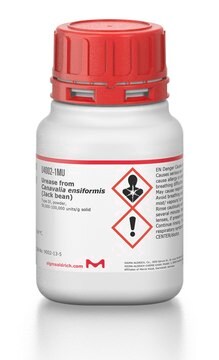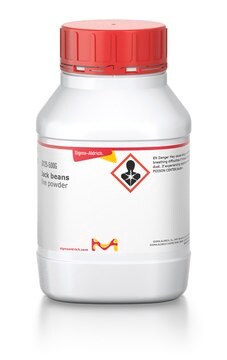U1500
Urease from Canavalia ensiformis (Jack bean)
Type III, powder, 15,000-50,000 units/g solid
Sinonimo/i:
Jack bean urease, Urea amidohydrolase
About This Item
Prodotti consigliati
Origine biologica
Canavalia ensiformis
Livello qualitativo
Tipo
Type III
Forma fisica
powder
Attività specifica
15,000-50,000 units/g solid
PM
~544620 Da
applicazioni
diagnostic assay manufacturing
Temperatura di conservazione
2-8°C
Cerchi prodotti simili? Visita Guida al confronto tra prodotti
Descrizione generale
Composed of six subunits with total molecular weight: ~544,620
Azioni biochim/fisiol
Definizione di unità
Avvertenze
Danger
Indicazioni di pericolo
Consigli di prudenza
Classi di pericolo
Eye Irrit. 2 - Resp. Sens. 1 - Skin Irrit. 2 - STOT SE 3
Organi bersaglio
Respiratory system
Codice della classe di stoccaggio
11 - Combustible Solids
Classe di pericolosità dell'acqua (WGK)
WGK 1
Certificati d'analisi (COA)
Cerca il Certificati d'analisi (COA) digitando il numero di lotto/batch corrispondente. I numeri di lotto o di batch sono stampati sull'etichetta dei prodotti dopo la parola ‘Lotto’ o ‘Batch’.
Possiedi già questo prodotto?
I documenti relativi ai prodotti acquistati recentemente sono disponibili nell’Archivio dei documenti.
I clienti hanno visto anche
Articoli
probiotics-and-human
Il team dei nostri ricercatori vanta grande esperienza in tutte le aree della ricerca quali Life Science, scienza dei materiali, sintesi chimica, cromatografia, discipline analitiche, ecc..
Contatta l'Assistenza Tecnica.












